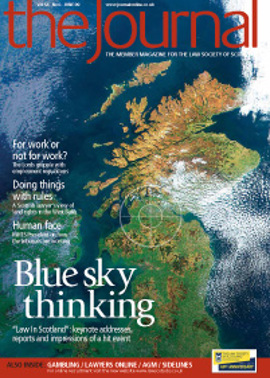Book reviews

International Money Laundering and Terrorist Finanacing – A UK Perspective
Paul Hynes, Richard Furlong and Nathanial Rudolf
PUBLISHER: SWEET & MAXWELL
ISBN: 1 84703 133 4
PRICE: £169
The authors of this worthwhile text set out to provide a guide for those professionals who are either themselves regulated in the areas of money laundering or act on behalf of clients who are regulated or who have fallen foul of the legislation and regulations.
The stated aim of the book is to “bring together the two strands of money laundering interest, the management of the risk from the perspective of business compliance, and the legal obligations and consequences which underpin and enforce it”. That aim is achieved in a clear and accessible text. For such a complex area of substantive law and regulation, this book is very readable. It is also admirably up to date.
As is noted by the authors, the scale of the problem sought to be addressed by the money laundering provisions is seen when reference is made to the Financial Action Task Force’s most recent figure that in 1996 between US $590 bn and $1.5 trillion were available for money laundering. The lower figure is equivalent to the economic output of a country the size of Spain.
The book provides a brief but interesting background to the development of this area of law in both its international and domestic context. Each of the international conventions and decisions are considered in more detail in Part E of the text. There is an extensive series of appendices of conventions, legislation, regulation, orders, and SOCA and HMRC forms.
The text breaks down into neat, easily navigable sections, such as who is subject to the regulations implementing the Third Directive, the role and duties of the nominated officer, and assessment of risk including reference to the Law Society of England & Wales guidance.
While the book reproduces the relevant legislation, its limiting feature is the absence of discussion of the treatment of the law in Scotland. This is particularly noticeable in the discussion on the application of the European Convention on Human Rights, article 6 in civil recovery or confiscation proceedings. There is no reference to the cases of Scottish Ministers v McGuffie [2006] CSOH 34 or Scottish Ministers v Buchanan 2007 SCLR 301, in which the court found the decisions of English and Northern Irish courts persuasive, and senior defence counsel was unsuccessful in arguing that the standard of proof under the legislation was incompatible with the presumption of innocence under the Convention, particularly in characterising the proceedings as in rem and not in personam.
In discussing the equivalent criminal provisions the authors quote the former Lord Chief Justice Lord Lane, who said of the Drug Trafficking Offences Act 1986: “The provisions are intentionally Draconian.” There then follows a valuable review of case law up to and including the House of Lords decision in R v May [2008] UKHL 28, where Lord Bingham laid out the questions the court must ask itself in considering confiscation proceedings: (1) has the accused benefited from the relevant criminal conduct; (2) if so, what is the value placed on that benefit; and (3) what sum is recoverable. The authors then discuss how those questions are answered, with detailed reference to authority. Each of the statutory concepts are considered in turn, such as what constitutes criminal activity, what amounts to criminal property and the interpretation by the courts of the prescribed criminal offences.
Criminal confiscation is admirably considered, providing clear authority to assist in the determination of the grounds on which restraint and eventual confiscation may be made, together with the assumptions the court may take into account.
The schedules of the Terrorism Act 2000 that address Scotland are, unfortunately, not reproduced. However, as the sections of the Act considered by the authors have application across the United Kingdom, their critique of the offences, penalties and orders under the legislation make valuable reading.
The value of this text is in the clear, concise and well referenced way it addresses the issues that may arise for the practitioner who needs to assess risk as someone who may require to disclose suspected money laundering activity, through to the criminal and civil consequences faced by someone alleged to have laundered money. While reference is made to English provisions and authority, as Dr Alastair Brown has noted in his recent text on money laundering (published by the same house) almost all the case law in this area of law derives from challenges before the English courts.
Between April 2007 and February 2008, the English courts made 4,504 confiscation orders with a value of £225,870,000. In Scotland, the figure is proportionally no less, comprising confiscation of £13.5m and recovery in civil proceedings of £7.4m. Given these figures, it is easily observed why the authors note on the first page that “money laundering is not a problem of banking or business or Government or law enforcement but of everyone”.
David J Dickson, Solicitor Advocate, Book Review Editor
Personal Injury Damages in Scotland
S A Bennett
PUBLISHER: BARNSTONEWORTH PRESS
ISBN: 0 95341 528 1
PRICE: £195
This is an exposition of the law governing the calculation of damages in personal injury cases in Scotland. Lord Hope commends it in his foreword – praise indeed – for organising the large body of case law which has built up in this subject and thereby making it more accessible to the practitioner. It provides a “one stop” source of information on personal injury damages which is far more wide ranging than one could reasonably expect from a single volume. The fact that it is now in looseleaf format, and capable of being updated to take account of the constant stream of new decisions, simply adds to its usefulness.
The opening chapters deal with familiar topics, including the types of damages that can be awarded in different cases – lump sum awards, interim damages, periodical payments, provisional damages – with copious footnote references to decided cases illustrating the principles outlined. The different heads of claim for personal injuries and fatal cases are all set out and explained in the general chapters of the book. These sections are short and succinct, and all the more helpful for that. The important statutes are reproduced in the text, exactly where you want to see them, and not tucked away in some appendix at the back.
A good example is the clear explanation of the multiplicand/multiplier approach to the calculation of future pecuniary loss. It is contrasted with the alternative method of assessing future loss of earnings by making lump sum awards. This, in turn, is supplemented by a footnote with at least 10 different illustrations of cases in which such awards were made. It is at points like this where the book proves its worth as a unique resource. These footnotes can be instantly followed up by going to the reports of the cases themselves in the edited judgments sections of the book, about which a more detailed comment is required.
In any collection of cases such as this, there can be an inevitable frustration that the text does not contain enough material to enable the reader to determine exactly what features were present in any individual case that might have influenced the type or level of award. This book, however, provides what are described as “edited judgments” of cases involving both non-pecuniary and pecuniary losses. There are about 700 such edited judgments. These comprise far more than the brief headnote which one often sees in case summaries. They give much more detail of the relevant circumstances of each case and enable the reader to appreciate instantly the factors that influenced the award. As the assessment of the value of a claim usually starts by making comparisons with similar awards, this enables the reader to see more easily if, and to what extent, earlier awards are truly similar. There are obvious advantages to the busy practitioner in having so much of the groundwork done in advance. I think this makes it an ideal book for keeping in the law library of your study at home (if you are sad enough to have a library – or a study – at home).
Lest anyone might think that is enough to be going on with, the book manages to round off this comprehensive coverage of all things PI with the full text of the Ogden Tables, life tables, gross to net income tables, and the Judicial Studies Board guidelines. All essential to the PI practitioner and all gathered under the one roof. If you cannot find the information you are looking for about damages in any PI case in this volume, then you are simply not looking hard enough.
Charles Hennessy
In this issue
- Spanish executry law – cross border issues
- The Scottish Parliament’s Emergency Bill procedure
- One year on
- Unequal before the law (1)
- Ian Smart's inauguration speech
- Your new First XI
- Dangerous loophole
- Unlocking the rule of law
- Our guiding light
- A hit for the conference
- Of chairs, trains and escalators
- Unequal before the law
- Matters of the mind
- New game, new rules
- Advance on all fronts
- Making openness work
- The First XI
- Society parleys with the OFT
- Professional Practice Committee
- Committees: the unsung heroes
- Find a client?
- Platform for success?
- Ask Ash
- Constant foe
- Killer question
- A time to be inventive
- Deep pockets required?
- Win some, lose some
- New client - new problems
- Website review
- Book reviews
- A business view






